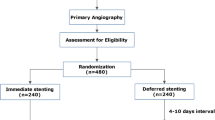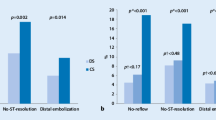Abstract
No consensus exists about which coronary artery should be firstly catheterized in primary PCIs. Initial catheterization of the “culprit artery” could reduce reperfusion time. However, complete knowledge of coronary anatomy could modify revascularization strategy. The objective of the study was to analyze this issue in ST-elevation myocardial infarction patients undergoing primary PCI. PCIs were performed in 384 consecutive patients. Choice of ipsilateral approach (IA): starting with a guiding catheter for the angiography and PCI of the “culprit artery”, or contralateral approach (CA): starting with a diagnostic catheter for the “non-culprit artery” and completing the angiography and PCI of the culprit with a guiding catheter was left to the operator. Differences between two approaches regarding reperfusion time, acute events or revascularization strategies were analyzed. There were no differences between two approaches regarding reperfusion time or clinical events. When the left coronary artery was responsible, IA was more frequent (76.4 vs 22.6 %), but when it was the right coronary artery, CA was preferred (20 vs 80 %); p < 0.0001. With CA, bare metal stents (BMS) were more used than drug eluting (DES) (60.8 vs 39.2 %) inversely than with IA (BMS 41.3 vs DES 59.7 %; p < 0.0001). With CA there were more patients with left main or multivessel disease in which revascularization was completed with non-urgent surgery (4.13 vs 2.4 %, p < 0.0001). Initial CA does not involve higher reperfusion time. Furthermore, overall knowledge of coronary anatomy offers more options in revascularization strategy and may imply a change in management. Despite the need to individualize each case, contralateral approach may be the first option with the exception of unstable patients.


Similar content being viewed by others
Abbreviations
- STEMI:
-
ST-elevation myocardial infarction
- PPCI:
-
Primary percutaneous coronary intervention
- DTB:
-
Door to balloon
- ATB:
-
Access to ballon
- LM:
-
Left main
- CABG:
-
Coronary artery bypass grafting
- IA:
-
Ipsilateral approach
- CA:
-
Contralateral approach
- RCA:
-
Right coronary artery
- LCA:
-
Left coronary artery
- BMS:
-
Bare metal stent
- DES:
-
Drug eluting stent
- DAPT:
-
Dual antiplatelet therapy
References
Levine GN, Bates ER, Blankenship JC, Bailey SR, BIttl JA, Cercek B, Chambers CE, Ellis SG, Guyton RA, Hollenberg SM, Khot UN, Lange RA, Mauri L, Mehran R, Moussa ID, Mukherjee D, Nallamoth BK, Ting HH (2011) Guideline for percutaneous coronary intervention. A report of the American College of Cardiology Foundation/American Heart Association Task Force on Practice Guidelines and the Society for Cardiovascular Angiography and Interventions. J Am Coll Cardiol 58:44–122
Nallamothu BK, Bradley EH, Krumholz HM (2007) Time to treatment in primary percutaneous coronary intervention. N Engl J Med 357:1631–1638
Keeley EC, Boura JA, Grines CL (2003) Primary angioplasty versus intravenous thrombolytic therapy for acute myocardial infarction: a quanti- tative review of 23 randomised trials. Lancet 361:13–20
Anderson JL, Adams CD, Antman EM, Bridges CR, Califf RM, Casey DE Jr, Chavey WE II, Fesmire FM, Hochman JS, Levin TN, Lincoff AM, Peterson ED, Theroux P, Wenger NK, Wright RS, Smith SC Jr, Jacobs AK, Halperin JL, Hunt SA, Krumholz HM, Kushner FG, Lytle BW, Nishimura R, Ornato JP, Page RL, Riegel B (2007) ACC/AHA 2007 guidelines for the management of patients with unstable angina/non ST-elevation myocardial infarction: a report of the American College of Cardiology/American Heart Association Task Force on Practice Guidelines (Writing Committee to Revise the 2002 Guidelines for the Management of Patients With Unstable Angina/Non ST-Elevation Myocardial Infarction): developed in collaboration with the American College of Emergency Physicians, the Society for Cardiovascular Angiography and Interventions, and the Society of Thoracic Surgeons: endorsed by the American Association of Cardiovascular and Pulmonary Rehabilitation and the Society for Academic Emergency Medicine. Circulation 116:148–304
Hioki H, Motoki H, Izawa A, Kashima Y, Miura T, Ebisawa S, Tomita T, Miyashita Y, Koyama J, Ikeda U (2015) Impact of oral beta-blocker therapy on mortality after primary percutaneous coronary intervention for Killip class 1 myocardial infarction. Heart Vessel. doi:10.1007/s00380-015-0673-1
Abe D, Sato A, Hoshi T, Takeyasu N, Misaki M, Hayashi M, Aonuma K (2014) Initial culprit-only versus initial multivessel percutaneous coronary intervention in patients with ST-segment elevation myocardial infarction: results from the Ibaraki Cardiovascular Assessment Study registry. Heart Vessel 29:171–177
Brodie BR, Stone GW, Morice MC, Cox DA, Garcia E, Mattos LA, Boura J, O’Neill WW, Stuckey TD, Milks S, Lansky AJ, Grines CL (2001) Importance of time to reperfusion on outcomes with primary coronary angioplasty for acute myocardial infarction (results from the Stent Primary Angioplasty in Myocardial Infarction Trial). Am J Cardiol 88:1085–1090
Cannon CP, Gibson CM, Lambrew CT, Shoultz DA, Levy D, French WJ, Gore JM, Weaver WD, Rogers WJ, Tiefenbrunn AJ (2000) Relationship of symptom-onset-to-balloon time and door-to-balloon time with mortality in patients undergoing angioplasty for acute myocardial infarction. JAMA 283:2941–2947
Bradley EH, Curry LA, Webster TR, Mattera JA, Roumanis SA, Radford MJ, McNamara RL, Barton BA, Berg DN, Krumholz HM (2006) Achieving rapid door-to-balloon times: how top hospitals improve complex clinical systems. Circulation 113:1079–1085
Bradley EH, Herrin J, Wang Y, Barton BA, Webster TR, Mattera JA, Roumanis SA, Curtis JP, Nallamothu BK, Magid DJ, McNamara RL, Parkosewich J, Loeb JM, Krumholz HM (2006) Strategies for reducing the door-to-balloon time in acute myocardial infarction. N Engl J Med 355:2308–2320
Swor R, Hegerberg S, McHugh-McNally A, Goldstein M, McEachin CC (2006) Prehospital 12-lead ECG: eficacy or effectiveness? Prehosp Emerg Care 10:374–377
Thatcher JL, Gilseth TA, Adlis S (2003) Improved eficiency in acute myocardial infarction care through commitment to emergency depart- ment-initiated primary PCI. J Invasive Cardiol 15:693–698
Jacoby J, Axelband J, Patterson J, Belletti D, Heller M (2005) Cardiac cath lab activation by the emergency physician without prior consultation decreases door-to-balloon time. J Invasive Cardiol 17:154–155
Lachance P, Dery JP, Beaudoin J, Barbeau GE, Noel B, Bertrand OF, Rodes-Cabau J, Nguyen CM, Proulx G, Gleeton O, Larose E, Roy L, Delarochelliere R (2008) ECG-guided immediate intervention at the time of primary PCI to reduce door-to-balloon time in ST-elevation myocardial infarction patients. J Invasive Cardiol 20:623–626
Chhatriwalla AK, Bhatt DL (2008) Breaking with tradition: is diagnostic angiography really necessary before primary PCI? J Invasive Cardiol 20:229–230
Chiang A, Gada H, Kodali SK, Lee MS, Jeremias A, Pinto DS, Bangalore S, Yeh RW, Henry TD, Lopez-Cruz G, Mehran R, Kirtane AJ (2014) Procedural variation in the performance of primary percutaneous coronary intervention for st-elevation myocardial infarction: a SCAI-Based Survey Study of US Interventional Cardiologists. Catheter Cardiovasc Interv 83:721–726
Deftereos S, Giannopoulos G, Raisakis K, Kaoukis A, Kossyvakis C, Pappas L, Panagopoulou V, Mavrogianni AD, Theodorakis A, Perpinia A, Michelakakis N, Bobotis G, Pyrgakis V (2011) Transradial access as firrst choice for primary percutaneous coronary interventions: experience from a tertiary hospital in Athens. Hellenic J Cardiol 52:111–117
Chodor P, Kurek T, Kowalczuk A, Swierad M, Was T, Honisz G, Swiat-kowski A, Streb W, Kalarus Z (2011) Radial vs femoral approach with StarClose clip placement for primary percutaneous coronary intervention in patients with ST-elevation myocardial infarction. RADIAMI II: a prospective, randomised, single centre trial. Kardiol Pol 69:763–771
Van’t Hof A, Widimsky P, Zahger D, Baumgartner H, Ceconi C, Dean V, Deaton C, Fagard R, Funck-Brentano C, Hasdai D, Hoes A, Kirchhof P, Kolh P, McDonagh T, Moulin C, Popescu BA, Reiner Z, Sechtem U, Sirnes PA, Tendera M, Torbicki A, Vahanian A, Windecker S, Astin F, Astrom-Olsson K, Budaj A, Clemmensen P, Collet JP, Fox KA, Fuat A, Gustiene O, Hamm CW, Kala P, Lancellotti P, Maggioni AP, Merkely B, Neumann FJ, Piepoli MF, Van de Werf F, Verheugt F, Wallentin L (2012) ESC guidelines for the management of acute myocardial infarction in patients presenting with ST-segment elevation: the Task Force on the Management of ST-segment elevation acute myocardial infarction of the European Society of Cardiology (ESC). Eur Heart J 33:2569–2619
Dib C, Hanna EB, Chaudhry MA, Hennebry TA, Stavrakis S, Abu-Fadel MS (2012) Culprit-vessel PCI followed by contralateral angiography. Tex Heart Inst J 39(3):359–364
Plourde G, Abdelaal E, Bataille Y, MacHaalany J, Déry U, Larose É, De Larochelliere R, Gleeton O, Barbeau G, Roy L, Costerousse O, Bertrand OF (2013) Effect on door-to-baloon time of immediate transradial percutaneous coronary intervention on culprit lesion in ST-elevation myocardial infarction compared to diagnostic angiography followed by primary percutaneous coronary intervention. Am J Cardiol 111:836–840
Moon KW, Kim JH, Kim JY, Jung MH, Kim GH, Yoo KD, Kim CM (2012) Reducing needle-to-balloon time by using a single guiding catheter during transradial primary coronary intervention. J Interv Cardiol 25:330–336
Chow J, Tan CH, Tin AS, Ong SH, Tan VH, Goh YS, Tan KS, Lingamanaicker J (2012) Feasibility of transradial coronay angiography and intervention using a single Ikari left guiding catheter for ST elevation myocardial infarction. J Interven Cardiol 25:235–244
Menees DS, Peterson ED, Wang Y, Curtis JP, Messenger JC, Rumsfeld JS, Gurm HS (2013) Door-to-balloon time and mortality among patients undergoing primary PCI. N Engl J Med 369:901–909
Zimetbaum PJ, Josephson ME (2003) Use of the electrocardiogram in acute myocardial infarction. N Engl J Med 348(10):933–940
Goldstein JA, Demetriou D, Grines CL, Pica M, Shoukfeh M, O’Neill WW (2000) Multiple complex coronary plaques in patients with acute myocardial infarction. N Engl J Med 343(13):915–922
Dziewierz A, Siudak Z, Rakowski T, Zasada W, Dubiel JS, Dudek D (2010) Impact of multivessel coronary artery disease and noninfarct-related artery revascularization on outcome of patients with ST-elevation myocardial infarction transferred for primary percutaneous coronary intervention (from the EUROTRANSFER Registry). Am J Cardiol 106(3):342–347
Di Mario C, Dudek D, Piscione F, Mielecki W, Savonitto S, Murena E, Dimopoulos K, Manari A, Gaspardone A, Ochala A, Zmudka K, Bolognese L, Steg PG, Flather M, CARESS-in-AMI (Combined Abciximab RE-teplase Stent Study in Acute Myocardial Infarction) Investigators (2008) Immediate angioplasty versus standard therapy with rescue angioplasty after thrombolysis in the Combined Abciximab REteplase Stent Study in Acute Myocardial Infarction (CARESS-in-AMI): an open, prospective, randomised, multicentre trial. Lancet 371(9612):559–568
Conflict of interest
There is no conflict of interest.
Author information
Authors and Affiliations
Corresponding author
Rights and permissions
About this article
Cite this article
Jurado-Román, A., García-Tejada, J., Hernández-Hernández, F. et al. Does reducing ischemia time justify to catheterize firstly the culprit artery in every primary PCI?. Heart Vessels 31, 1022–1029 (2016). https://doi.org/10.1007/s00380-015-0706-9
Received:
Accepted:
Published:
Issue Date:
DOI: https://doi.org/10.1007/s00380-015-0706-9




